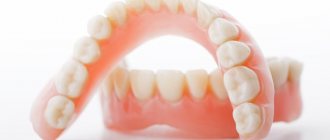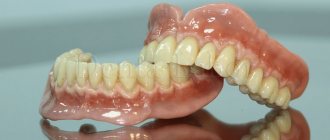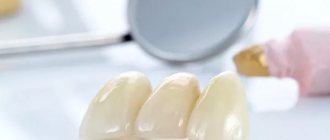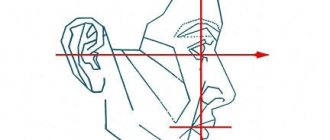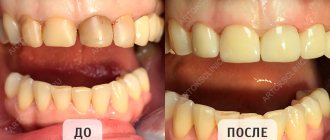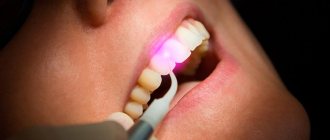The Smile-at-Once clinic uses new generation composites - increased strength using nanoparticles. Despite the fact that they are stronger than classical materials, the patient in any case needs to follow the rules for caring for the extended teeth.
Extensions are very similar to regular fillings, since the same materials are used. Therefore, the rules of care are largely similar. However, there are also differences - artistic restoration is carried out in a more elaborate manner, since a small piece or even a whole crown is built up. The composite is fixed on top, and not placed inside the cavity, so the absence of walls imposes certain obligations in terms of caring for such teeth.
How much should you not eat after teeth extensions?
Since anesthesia is used for recovery, you should avoid eating for 2-3 hours after the end of treatment. You need to wait until the numbness goes away completely, otherwise you may accidentally bite your lip, tongue or cheek while chewing.
Modern photopolymer dental fillings harden under the influence of a special lamp almost instantly, so the load on them will not lead to shrinkage of the material - if anesthesia was not used, you can eat right away. But it is better to give preference to softer and warmer foods.
If the tooth has been significantly damaged and a pin or stump insert was used as additional support, you should avoid eating hot or very cold food for the first 24 hours, since special dental cement was used - its fixing properties may become worse under temperature stress.
What's the price?
Anesthesia - 450 rub.
Restoration of one tooth costs from 3,500 to 5,500 rubles, depending on the degree of destruction.
If it is necessary to use a pin, it is added to the cost.
The cost of the anchor pin is 1000 rubles.
The cost of using a fiberglass pin is 1,900 rubles.
Veneer installation - from RUB 15,000
Installation of composite veneers - from 12,000 rubles.
The price of the procedure will depend on the materials chosen, as well as the size of the damaged area. The more teeth you need to restore, the higher the cost will be.
You can find out more about prices on our price list page.
What dietary restrictions are there after dental restoration?
Modern composites, even despite their high performance characteristics, are susceptible to staining, which is why even if the filling is in good condition, after a few years it becomes darker compared to natural enamel. Over time, a clear contrast will be felt between the living tooth and the extended piece.
Extended teeth are quite weak - under load, a piece of filling material can break off. Especially when carrying out restoration of the frontal zone. All this requires following a certain diet.
- coffee, tea, red wine, sweet colored soda, beets, sauces (especially tomato and soy), berries, candies and caramel are not recommended - that is, all products that over time will lead to a change in the shade of the extension,
- Avoid eating solid vegetables and fruits whole - it is better to cut them into pieces and chew them with unextended teeth. This is especially true if the front teeth have been restored - they should not bite off hard foods, gnaw seeds,
- give up the habit of cracking nuts or cracking seeds, gnawing crackers with extended teeth,
- Chew food slowly, especially if it is hard or fibrous,
- Avoid food that is too hot or cold - it can cause cracks and chips in the material.
If women have extended front teeth, it is better to avoid bright lipsticks, since composites can again become stained.
Advantages of veneers
Indirect dental restoration using the installation of the thinnest plates is in demand today not only by public figures, but also by ordinary people who dream of eliminating imperfections of elements. Veneering involves grinding down 0.5–0.7 mm, after which plates of the selected shade made from individual impressions are glued onto the polished surface. Dental restoration using this method involves processing from 4 to 10 units in a row, that is, a plate is not placed on a separate element. There are some contraindications for the installation of such structures: grinding gums (bruxism), pathological inflammation of soft tissues, a high degree of abrasion of hard tissues on which it is impossible to attach elements. In addition, the installation of onlays is not recommended in the presence of dentures made of hard materials. Otherwise, indirect dental restoration has many advantages.
- The high aesthetic component of the procedure allows you to create a dazzling smile and hide imperfections.
- Sufficient mechanical strength of the plates, resistance to temperature changes, and the influence of food coloring.
- The tight fit of the plates protects the enamel from external influences, protects it from destruction, and prevents the penetration of bacteria.
- The ability to bind together disparate elements, reducing loosening that occurs with age.
- Elimination of yellowness, fluorosis, chips and microcracks resulting from damage and injury.
- The possibility of covering not only the front part, which preserves the taste sensitivity of the units, but also “dressing” the tooth on both sides to increase strength.
NEED TO KNOW! Veneers can be ceramic, composite or zirconium. The former are distinguished by a higher aesthetic component and increased whiteness. However, ceramics is a rather fragile material. Polymer-based composites are characterized by a less attractive appearance, but are more practical and quite affordable. Zirconium guarantees the longest life of the plates.
How to do oral hygiene
If it is impossible to refuse drinks and foods that stain filling materials, you need to pay increased attention to hygiene. In such situations, cleaning after every meal is mandatory.
- cleaning in the morning and evening (before and after breakfast, as well as after the last meal) with a medium-hard brush,
- irrigator, dental floss, brushes and rinse for cleaning the interdental spaces after each meal and even after a regular snack.
Materials used
The cost of dental restoration directly depends on the materials used. Extension on a pin involves implanting a rod made of titanium, steel or fiberglass into the bone tissue. The first material enjoys well-deserved popularity due to its unique combination of low weight, amazing strength, and environmental safety. The alloy, widespread in various areas of the national economy, integrates perfectly into the oral cavity without causing side effects. Surgical steel is an equally common material for dental restoration, characterized by high resistance to mechanical and thermal stress. As for fiberglass, recently the carbon variety of nanomaterial, which has the ability to adapt to the structure and behavior of the patient’s soft tissues and evenly distribute chewing loads, has become increasingly in demand. When restoring teeth using traditional methods using crowns, various materials are also used.
- Ceramics are an aesthetically beautiful solution that provides a snow-white smile and an attractive appearance. It requires careful care, is highly fragile and does not have a very long lifespan.
- Metal is an obsolete material that is currently almost never used. However, in terms of strength characteristics it surpasses its competitors, so products made from alloys are still in demand.
- Metal-ceramics is an intermediate and most successful option. Combines the attractiveness of the first and the reliability of the second material. The affordable price explains the high demand for metal-ceramic crowns.
FACT! Ceramics and metal ceramics, due to the addition of useful microelements and a tight fit, provide reliable protection of units from pathogenic microbes. Therefore, dentists consider ceramic crowns and veneers not only an effective aesthetic solution, but also a powerful preventive measure. According to doctors, people with such structures in their mouths after dental restoration are less likely to develop superficial, medium and deep caries.
Does the restoration need to be changed and when might it be necessary?
On average, the service life of composite extensions is about 3-5 years. Such a filling may last longer, but it will stand out on the front teeth after 3-4 years. Composites shrink, albeit slightly, so over time a small step will appear between the tooth and the filling material. This is especially noticeable on the front teeth if they are partially restored. In such a situation, you can update the restoration, that is, completely grind it down and replace it with a new one. Or simply re-build it up with a composite on top - in certain situations this is also allowed.
Advantages of composites
Modern compounds used for dental restoration are distinguished by high strength, durability, and the ability to choose any shade. In this regard, many patients often go too far, wanting to have unnaturally snow-white units. The focus on media characters is commendable, but it is worth remembering that such elements require careful care, which requires time and money. Our clinic’s specialists are inclined towards the option of restoring teeth using natural-colored composites. Indications for the use of such compositions include many factors. Among them are caries in the spot stage, extensive lesions, pigmentation, and unusability of old fillings. The only disadvantage noted by experts is the gradual “eating” of the layer. Over 10–12 years, the material shrinks, as a result of which a repeat procedure is necessary. But the benefits of dental restoration using composites are much greater.
- There is no need for deep grinding of the elements to the stump, which prolongs the life of the units and relieves the patient of discomfort.
- The materials used are completely safe, have no contraindications and are perfectly integrated into the oral cavity.
- The high strength of gel-like compositions virtually eliminates the possibility of scratches on the applied surface.
- The latest generation polymers used to prepare composite compositions are able to withstand critical temperatures.
- The ability to restore the aesthetic and functional role of the anterior and lateral units in one visit to the doctor attracts clients.
IMPORTANT! When restoring teeth using composite compounds, the doctor always has the opportunity to adjust the result. If there is a shortage of material, an additional layer is applied, and if there is an excess, the excess is ground off. The financial aspect is also a significant advantage. The procedure for restoring functionality in one visit to the dentist saves not only time, but also money for the client.
How to grow your front teeth?
There are several ways to build up your front teeth. In most cases, it will be possible to restore functional and aesthetic characteristics using photocomposites. By applying the material layer by layer to the defect site, the doctor can completely eliminate the defects. The only negative: in order to preserve the aesthetic properties for as long as possible, you will have to adhere to some dietary restrictions at home, as well as regularly seek professional teeth cleaning.
If more than 70% of the crown part of the tooth is missing, then it is ideal to turn to an orthopedic technique. Modern ceramics used to make crowns make it possible to perfectly imitate the texture of a tooth and achieve a match in color and transparency to natural enamel.
Another current way to correct teeth in the smile area is to build teeth using veneers. They can be composite and made by a doctor directly in the patient’s mouth, as well as ceramic. The production of these onlays takes place in a dental laboratory, after which they are glued to the teeth using special cement. The thickness of the linings is small. However, in order not to excessively increase the tooth surface with such a procedure and to ensure strength, grinding of the tooth surface will be required. Videos available in the public domain will allow you to verify the careful approach of specialists to such a procedure.
Advantages and disadvantages of extensions
The benefits of dental extensions include:
- Possibility of ensuring reliable tooth restoration. In some cases, an extended tooth is not much inferior in wear resistance and durability to a natural one.
- Natural result. Thanks to modern materials, it is possible to choose not only the desired shade of the tooth, but also provide the necessary transparency. The extended tooth will not be distinguishable from its neighbors. A natural smile is guaranteed.
- High efficiency of the procedure. The result is achieved even if even a tooth from which practically nothing remains is subject to restoration.
- Possibility of quickly obtaining results. Depending on the chosen method, 1-2 visits to the doctor are enough.
Cons of teeth extensions:
- Quite a high cost;
- The inability to clearly determine how long the service life of a tooth will be;
- Dependence of results on the professional skills of the doctor.
Contraindications
There are few contraindications to dental extensions. Among them:
- Complete destruction of the crown part of the tooth;
- Tooth mobility due to damage to periodontal tissues;
- Bruxism;
- Allergic reactions to the materials used;
- Severe dysfunction of the temporomandibular joint.
The decision on the possibility of using a particular technique in each specific case is made by the dentist.
FAQ
- What kind of doctor does dental extensions? Depending on the technique used, a dentist-therapist or an orthopedist will solve the problems.
- Will it be possible to build up baby teeth? Is such a procedure necessary? At the present stage, using modern filling materials, it is possible to solve the problem with baby teeth. However, treatment is complicated by the fact that it is difficult to ensure a static position for the child during the manipulation. Often you have to resort to anesthesia. The need for such a procedure is justified by the fact that ignoring it will lead not only to deterioration of aesthetics, but also to problems with bite and diction disorders.
Price
The cost of tooth augmentation varies widely depending on the technique used. In this case, the most accessible way is to use therapeutic approaches. The use of orthopedic techniques will be more expensive. Due to the complexity of the technology, the installation of ceramic veneers will be especially expensive. The price of such a procedure also increases due to the fact that the entire smile area is subject to correction. To achieve the desired result, you will need to install about 8-10 units of overlays. At the same time, if you are counting on having your teeth augmented in a center whose core business is to provide the population with high-quality but affordable services, contact the Evita clinic.
| Cosmetic tooth restoration with light-curing materials | 9600 rub. |
| Ceramic inlay (1 unit) | 35400 rub. |
| Ceramic veneer (1 unit) | 48,000 rub. |
| Lumineers veneer (1 unit) | 82700 rub. |
| Veneer Emax (1 unit) | 48,000 rub. |
Preparing to restore teeth using extensions
- Make an appointment with a dentist to decide on an option for restoring a tooth or several teeth.
- The specialist uses a composite scale to determine the natural shade of your teeth and select the required color for a filling or crown.
- It is imperative to do an X-ray examination of the roots and canals of the teeth to exclude pathological processes and, if necessary, prescribe treatment.
- If you want to achieve impeccable aesthetics, before adding teeth, the remaining teeth are whitened, and the color and transparency of the new tooth (which is being restored) is matched to the rest.
- If you have dental caries or gum disease, they must be treated. Only treated and thoroughly examined dental units can be restored!
- Preventive teeth cleaning and removal of hard and soft plaque are performed.
Examples of “before/after” work
Category: Aesthetic dentistry
Expert of the article you are reading:
Bystrov Alexey Albertovich
Dentist orthodontist, general dentist
You may also be interested in:
Ceramic veneers Lumineers price for 1 tooth in Moscow Ceramic veneers E-max
Show more
Indications
The main indications for dental restoration procedures are:
- The appearance or spots of cracks in the enamel,
- Mechanical injuries
- Increased sensitivity of teeth,
- Congenital defects (gaps between teeth, irregular shape),
- Age-related changes (teeth wear),
- Caries.
It is worth remembering that the teeth extension procedure cannot be performed on patients who are allergic to composite materials and people suffering from bruxism.
Dental augmentation corrects the irregular shape of a tooth, allows you to change its color, and adjust its position relative to the general row. This is an effective way to eliminate visible imperfections while fully preserving dental functions.
Reviews about lumineers, veneers, inlays, crowns
I installed lumineers because there is no need to grind down the teeth and they can be removed. Although I have no plans to remove the lumineers, it is good to know that under the plates my teeth have intact enamel.
I installed veneers, and several years later I don’t regret it. I enjoy a beautiful smile, but before I was embarrassed to smile in front of people.
I've had an inlay on my chewing tooth for seven years now, and I'm happy with it. There was no other way out in my situation.
Several years ago I put a metal-ceramic crown on a chewing tooth. Durable, you don’t feel a foreign body in your mouth, it’s only different in color, but this is not so important, since no one sees it when you smile.
